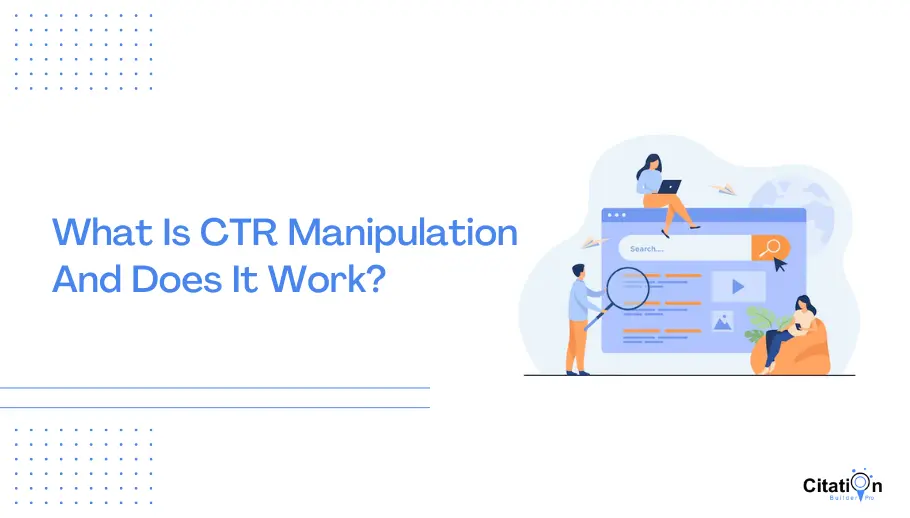Just How to Measure the Effect of CTR Control on Your Advertising
Understanding the subtleties of click-through rate (CTR) control in marketing is necessary for businesses aiming for authentic user engagement. By examining key metrics such as conversion rates and bounce rates, marketing professionals can discover potential discrepancies that might emerge from fabricated improvements. Using tools like Google Analytics and carrying out A/B screening can offer insights right into the efficiency of numerous methods. Nevertheless, the implications expand past immediate data; the long-term effects on brand name integrity and individual trust fund warrant cautious consideration. What stays to be explored is exactly how these elements adjoin and influence total advertising success.
Understanding CTR Manipulation
Recognizing CTR manipulation is necessary for online marketers looking for to enhance their campaigns and ensure data honesty. Click-through rate (CTR) describes the proportion of users who click on a certain web link to the complete number of users who check out the advertisement or material. Adjustment of this metric can take place through various means, including using deceitful advertising and marketing methods, click farms, or automated crawlers. These techniques can artificially inflate CTR figures, leading to misdirected marketing approaches and misallocation of resources.
The implications of CTR manipulation extend past mere information distortion; they can threaten rely on electronic advertising. When businesses rely on inflated metrics, they may spend in ineffective projects, ultimately harming their roi. In addition, systems may punish marketers taking part in such methods, resulting in further implications for their marketing initiatives.
To efficiently battle CTR adjustment, marketers need to develop a comprehensive understanding of their information resources and analytics devices. By using sophisticated tracking approaches and inspecting traffic resources, they can ensure and recognize irregular patterns that their performance metrics mirror genuine individual engagement - LinkDaddy CTR Manipulation. This caution is important for cultivating long-term success in a significantly competitive electronic landscape
Key Metrics to Examine
Effective evaluation of crucial metrics is crucial for reviewing the true efficiency of advertising campaigns and finding potential CTR control. One key metric to take into consideration is the Click-Through Rate (CTR) itself, which stands for the proportion of users that click on an advertisement to the complete number of individuals who watch it. A sudden spike in CTR may suggest adjustment, necessitating more investigation.
Additionally, checking conversion prices is important. A high CTR with a reduced conversion price could signal that the clicks are not authentic or that the targeting is misaligned (GMB CTR Manipulation). Likewise, assessing bounce rates can offer insight into user involvement; a high bounce price after a click might recommend that the website traffic is not quality-driven.

Tools for Measurement

Furthermore, A/B screening tools such as Optimizely or VWO can assist in experimentation with different advertisement versions to identify which aspects drive greater CTR. These tools enable marketing experts to assess real-time performance and make data-driven modifications. Social network analytics devices, like Hootsuite or Sprout Social, can also be important in comprehending CTR within social systems, supplying understandings into audience habits and interaction patterns.
Additionally, warmth mapping tools, such as Hotjar, can reveal how users connect with advertisements, assisting to identify where renovations can be made. Combining these devices creates a robust dimension structure, allowing marketing professionals to recognize the impacts of CTR control successfully. Eventually, the best choice of dimension devices is important for making informed advertising and marketing choices and enhancing campaign efficiency.

Reviewing Long-term Results
One must think about the lasting results of CTR manipulation on overall advertising and marketing performance, as short-term gains can commonly mask much deeper implications. Over time, unnaturally inflated click-through rates may result in reduced depend on from customers and internet search engine alike. When users continuously run into deceitful techniques, they might become hesitant to engage with the brand, resulting in lower conversion rates in the future.
Additionally, algorithm updates from platforms such as Google are designed to prioritize genuine involvement over filled with my review here air metrics. Subsequently, businesses that rely on CTR manipulation might locate themselves punished, resulting in a decline in organic reach and visibility. This can have a cascading effect on brand integrity and client commitment, inevitably threatening the check it out very objectives that the initial adjustment looked for to attain.
Furthermore, the data collected from adjusted CTR might misinform marketing experts in their approach advancement. Counting on manipulated data can result in illinformed projects that fail to resonate with the target audience, bring about lost resources and missed out on opportunities. Consequently, it is crucial for marketing experts to evaluate the long-term implications of CTR manipulation and focus on sustainable, ethical interaction strategies for lasting success.
Moral Considerations in CTR Manipulation
In the world of electronic advertising, ethical factors to consider surrounding CTR manipulation are paramount. While the wish to boost click-through rates (CTR) can cause temporary gains, the prospective long-term consequences on brand name integrity and consumer depend on can not be overlooked. Controling CTR often includes methods that might deceive individuals, such as clickbait headings or misleading marketing techniques. These strategies can result in a transient boost in website traffic but may eventually deteriorate consumer self-confidence.
Additionally, honest worries expand to conformity with guidelines such as the Federal Profession Compensation (FTC) standards, which mandate openness in advertising and marketing. Falling short to comply with these criteria can reveal services to lawful implications and damage their track record. Marketers must consider the effects of their methods on customer experience and the more comprehensive market landscape.
Additionally, the increase of man-made knowledge and automation in advertising presents additional honest problems. Ultimately, ethical advertising techniques should focus on transparency, honesty, and respect for the customer, fostering lasting partnerships that transcend simple metrics like CTR.
Final Thought
In verdict, gauging the influence of CTR adjustment on advertising and marketing calls for a thorough evaluation of essential metrics, including click-through this page prices, conversion rates, and bounce rates. Ultimately, a data-driven strategy makes certain that advertising and marketing methods are effective and straightened with real individual interactions.
Recognizing the subtleties of click-through rate (CTR) control in advertising is vital for businesses making every effort for authentic user involvement.Effective evaluation of crucial metrics is crucial for evaluating the real performance of advertising and marketing campaigns and detecting possible CTR manipulation.One must think about the long-term results of CTR manipulation on total advertising efficiency, as temporary gains can usually mask deeper effects.In the realm of electronic advertising, honest factors to consider surrounding CTR adjustment are paramount.In final thought, determining the effect of CTR control on advertising and marketing calls for a detailed evaluation of vital metrics, consisting of click-through prices, conversion prices, and bounce rates.